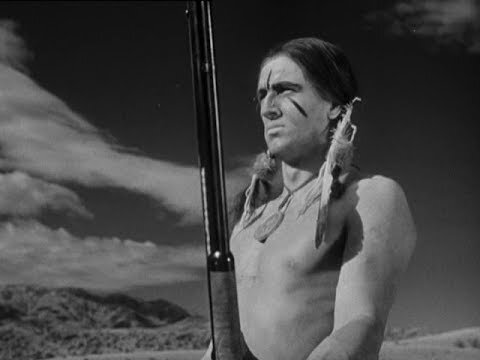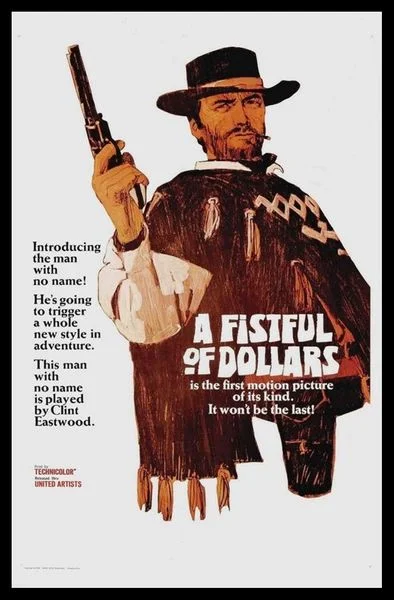Western #7: Winchester '73
Westerns during the Hollywood studio system usually adhere closely to all the conventions of the genre, and Winchester ‘73 (1950) mostly falls in line, with the exception of the non-traditional narrative construction and a few flashes of brilliant camera composition. Directed by Anthony Mann and (mostly) starring Jimmy Stewart, the film’s story focuses on a gun that changes hands throughout the plot, enabling the filmmakers to showcase the different archetypes and locations around the West. This is the penultimate movie in the Western Marathon, so let’s follow along on the journey of the most famed gun in the West, Winchester ‘73.
Dodge City, a town famous for not allowing firearms within the city limits, is hosting a shooting competition, with the prize a coveted and rare Winchester 1873 rifle. Hosted by sheriff Wyatt Earp, the competition comes down to Lin McAdam (James Stewart) and Dutch Henry Brown (Stephen McNally), with McAdam as the ultimate winner. Turns out McAdam and Brown are rivals with a score to settle, and Brown’s gang takes revenge by attacking and robbing McAdam of the rare rifle. Brown leaves town, but soon loses the gun to an Indian Trader in a round of poker; the Indian Trader loses the gun (and his scalp) to an Indian chief named Young Bull (Rock Hudson). The Indian tribe attacks an encampment of soldiers and Young Bull is killed in the ensuing battle; the Winchester is found on the battlefield and given to a man named Steve and his fiancee Lola (Shelley Winters), who had taken refuge with the soldiers. Steve and Lola head to their new house, but are ambushed by a gang of outlaws led by a man named Waco, who kills Steve to get the gun and kidnaps Lola. They return to their hideout, reuniting with Brown, and begin to plot their next criminal act - an armed robbery in town. After the plan is botched, McAdam follows Brown (who has the gun) outside of town and confronts him for a tense shootout on the rocky cliffs in the desert. McAdam ultimately prevails in killing Brown, who is revealed to be his treacherous brother, and recovers the Winchester for himself.
If that summary recap of the plot felt a bit all over the place, with a large amount of random characters who dip in and out of the story, many of them who end up killed, then that is an accurate reflection of the film’s chosen narrative structure. Although the film stars Jimmy Stewart, his presence is not prominently felt throughout the film; in fact, the plot spends long stretches away from the main character, who is constantly two steps away from the gun. The Winchester itself is the star of the film, with set pieces built around the various characters that cross its path. While an interesting conceit, this construction means the audience is given little time to engage and build a relationship with a set of characters that we care about and root for over the course of the film; instead, we are given interesting scenes where new characters are constantly being introduced, and then the gun is off to a new pair of hands. It doesn’t help that Stewart’s performance is missing his usual charm and is asked to perform violence that goes against his established star persona, which doesn’t come off as authentic. There are a few highlights, specifically when Steve and Lola are being held hostage in their new home by a gang of outlaws, a well written sequence full of tension and believable human interaction. But overall, following the gun through multiple set pieces didn’t pull together enough narrative threads to be compelling over the film’s runtime.
Considering the film through the lens of racial construction, it fails early and often. As the camera pans across the western landscape, the title cards appear to introduce the story about the Winchester Rifle: “To cowman, outlaw, peace officer or soldier, the Winchester ‘73 was a treasured possession. An Indian would sell his soul to own one…” While describing the gun as a prized piece of property to the white man, the introduction paints the Native Americans as a less civilized man that would trade his humanity for the same possession, positioning the tribes as lesser than the white frontiersman and setting the assumption that the group would be willing to take dehumanizing action. This outright racism is not a great start, but the film becomes even more egregious in its portrayal of Native Americans, casting a very white Rock Hudson as the chief Young Bull; this choice is typical of the Hollywood studio system of the time, and yet still rankles that misrepresentation was so acceptable. Finally, the Native Americans aren’t given any depth at all in their screen portrayal. Young Bull and his tribe are given no backstory, besides admiring the defeat of Custer at the Battle of Little Bighorn, they are just presumed to be the enemy; so the script asks no questions when they steal the gun and attack the army in the remote desert. As so often is the case with Western genres of the Hollywood Studio era viewed in modern times, the portrayal of the indigenous people is one note and anchored with an underlying set of racist assumptions.
The gender politics of the film, however, are a step above the racial considerations and are mostly played out between Steve and his fiancee Lola. As they head toward their new ranch home, the two are chased by an Indian tribe, and Steve literally leaves his woman to handle the carriage while he escapes on horseback! He eventually comes back for her, but she does not fail to notice that he abandoned her in a moment of terror; once they reach the relative safety of the army encampment, Lola makes it plain to Steve that he has been lowered in her esteem by the way she interacts with the other men in the station, including kissing the colonel and blatantly flirting with Jimmy Stewart’s McAdam. In an impressive scene that was a highlight of the script and acting, McAdam gives her a gun just before the Indian attack on the army camp and, with a silent moment of struggle, followed by the line “I understand about the last one,” highlights the real danger that women had for bodily harm in the wild West. Her interactions with Stewart’s character display an affection without overly romantic overtones. Overall, Lola is a highlight in the film, and becomes even better once she becomes a hostage and her sassy protestation of the dire situation displays a defiance that is refreshing.
The film’s director Anthony Mann occasionally rises above the standards of the Hollywood studio system to include some sophisticated shot compositions, as well as thrilling action sequences. While Steve and Lola are hostages in their own house, a fire breaks out and it is clear the actors are performing in front of a live fire! Additionally, during the sequence where the Native Americans are attacking the army camp, the camera frames the action to show how close the force is to the camp, visually drawing out the physical space so the viewer doesn’t get spatially lost. And the last noteworthy action sequence is the finale where the two brothers are in a shootout amongst the rocky desert setting, where McAdam is attempting to climb the rocks to gain advantage over Brown, who is positioned at the top of the hill. Mann is actually shooting on location and finds interesting angles to frame their maneuvering through the rocks and hills.
The best framed sequence in the film occurs at Riker’s bar between Brown’s gang and the Indian Trader who gains advantage over the trio of men. Brown’s men have the valuable Winchester, but otherwise they left Dodge City without the rest of their cache of guns, so are in desperate need, especially with McAdam on their trail. Brown attempts to goad the Indian Trader into playing poker, hoping to bleed him dry and acquire their needed guns. The Indian Trader is sitting in the foreground, with the three thugs in the back table, using the depth to show the distance between the two rivals. Brown approaches the front table, and his movement now reveals all four of the players in the camera’s field of vision, the blocking showing the threat of numbers the gang has over the lone Indian Trader. When the plot returns back to Riker’s bar at the conclusion of the poker game, where the Indian Trader has wiped Brown clean of his remaining possessions, the camera is placed at an askew angle, showing the thugs in defeat. This juxtapositioning of the camera between the two scenes displayed the shifting power dynamics between the two camps as the poker game progressed. For a film that mostly stayed within the confines of standard Hollywood composition, this scene was noteworthy for the camera’s commentary on character dynamics.
In considering Winchester ‘73, there are moments that stood out as highlights, but overall the film’s experimental narrative structure pulled the audience away from tight connections with characters, leaving more of a hodge podge sequence of set pieces. While the portrayal of Lola as a strong Western woman was notable, the script’s approach to Native Americans, and especially the casting of a very white Rock Hudson to play Young Bull, reveals the ingrained racism of the 1950s society in which the film was made. Mann executed the action sequences well and inserted some artistic license into the scenes at Riker’s bar, but otherwise put together a standard Hollywood studio system fare. These factors place the film in the lower end of the pack of the films considered within this Western Marathon and, with only one film left to review, we move on to see how Sam Peckinpah’s The Wild Bunch (1969) stacks up against the competition.








